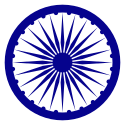Unia Indyjska
| 1947–1950 | |||||
| |||||
 | |||||
| Język urzędowy | |||||
|---|---|---|---|---|---|
| Stolica | |||||
| Ustrój polityczny | |||||
| Głowa państwa | |||||
| W jego imieniu | |||||
| Szef rządu | |||||
| Powierzchnia • całkowita • wody śródlądowe |
| ||||
| Liczba ludności (1950) • całkowita • gęstość zaludnienia • narody i grupy etniczne |
| ||||
| Waluta | |||||
| Niepodległość | |||||
| Ustanowienie republiki | |||||
| Religia dominująca | |||||
| Strefa czasowa | UTC +5:30 | ||||
Unia Indyjska (ang. Union of India, czasami także Dominium Indii) – historyczne państwo położone w Azji, na terenie obecnych Indii, istniejące w latach 1947–1950.
Unia Indyjska była bezpośrednim poprzednikiem istniejącego dziś państwa indyjskiego, powstała 15 sierpnia 1947 roku w wyniku deklaracji niepodległości Indii. Było to państwo o ustroju monarchicznym, będące w unii personalnej z Wielką Brytanią. 26 stycznia 1950 roku państwo uległo przekształceniu w obecnie istniejącą Republikę Indii.
Gubernatorzy generalni Indii
- Louis Mountbatten (1947–1948)
- Chakravarthi Rajagopalachari (1948–1950)
Premierzy
- Jawaharlal Nehru (1947–1950)
Zobacz też
Media użyte na tej stronie
The Flag of India. The colours are saffron, white and green. The navy blue wheel in the center of the flag has a diameter approximately the width of the white band and is called Ashoka's Dharma Chakra, with 24 spokes (after Ashoka, the Great). Each spoke depicts one hour of the day, portraying the prevalence of righteousness all 24 hours of it.
Ashoka's dharma chakra, with 24 spokes (after Ashoka, the Great). Each spoke depicts one of the 24 virtues. They are as followed.
Autor: Anshulkumardhiman (talk), Licencja: CC BY 3.0
Dominion of India. Area controlled by Dominion of India in dark green




